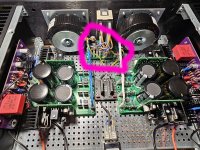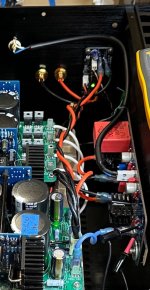Keep in mind that even your excellent QuantAsylum equipment has own distortion and noise comparable to this amplifier at 1W. I had to purchase a new measurement gear.Full day ahead, but I may have some time to do a few measurements.
IAIMH,
Your fresh build has motivated me to bump up the bias a bit.
After an hour of playing time, checked the voltage at R17 and it’s 0V252, exactly the same as the day the lid was installed 3 months ago. Now both channels are set to 0V300.
The Kill-A-Watt meter was showing 105W now showing 116W from the wall.
👍🏻
Edit:
Temperature increased by 3°C, now sinks are 39°C
Your fresh build has motivated me to bump up the bias a bit.
After an hour of playing time, checked the voltage at R17 and it’s 0V252, exactly the same as the day the lid was installed 3 months ago. Now both channels are set to 0V300.
The Kill-A-Watt meter was showing 105W now showing 116W from the wall.
👍🏻
Edit:
Temperature increased by 3°C, now sinks are 39°C
Last edited:
I had some time free up. I was listening to the amp in the background most of morning. I also did some quick and dirty measurements. I am still learning how to measure properly, and this was far from ideal. Mainly, I wanted to make sure that it was at the very least built without any major flaw that would show up in measurements, but not through listening.
tl;dr - it all seems just fine to me on both accounts.
Quick Power vs. THD - Both channels behave identically and to expectations for all practical purposes.
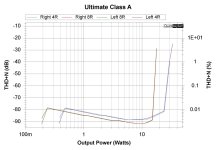
Representative channel at 1W 4R and 1W 8R - channels behave the same for all practical purposes.
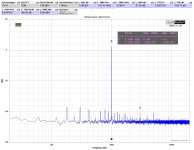

PSU is clean enough. It's not to the extremes of my "wretched excess" external PSU, but it's quite good and about 1/10th the weight... and it's in the same chassis.
15W 8R and 25W 4R - Practical / Rounded power output limits.
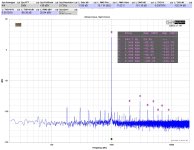
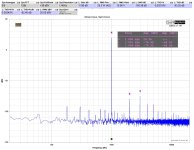
Clipping behavior into 8R - Nice and even. I could have sworn I did 4R also... but I may have forgotten to save the graph.
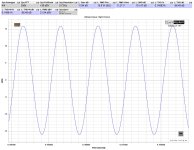
Noise and A-weighted noise. Looks a mess, but it's all below ~95dBV. What really matters is that it's dead quiet...
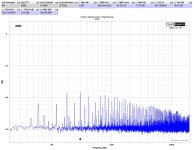

What I built this amp for and what it definitely excels at is low-level listening. However, what I also wanted was a "bullet-proof" system for when kids come over and want to turn it up to "11". With an Iron Pre at 6dB of gain + the 12dB of gain with the amp, it can be safely turned ALL the way up. It plays to pleasant if not loud volumes without sounding strained at all.
More to come, but lovely, lovely amplifier.
If anyone sees anything of concern, let me know, but for now... it's just getting settled into the system.
tl;dr - it all seems just fine to me on both accounts.
Quick Power vs. THD - Both channels behave identically and to expectations for all practical purposes.

Representative channel at 1W 4R and 1W 8R - channels behave the same for all practical purposes.


PSU is clean enough. It's not to the extremes of my "wretched excess" external PSU, but it's quite good and about 1/10th the weight... and it's in the same chassis.
15W 8R and 25W 4R - Practical / Rounded power output limits.


Clipping behavior into 8R - Nice and even. I could have sworn I did 4R also... but I may have forgotten to save the graph.

Noise and A-weighted noise. Looks a mess, but it's all below ~95dBV. What really matters is that it's dead quiet...


What I built this amp for and what it definitely excels at is low-level listening. However, what I also wanted was a "bullet-proof" system for when kids come over and want to turn it up to "11". With an Iron Pre at 6dB of gain + the 12dB of gain with the amp, it can be safely turned ALL the way up. It plays to pleasant if not loud volumes without sounding strained at all.
More to come, but lovely, lovely amplifier.
If anyone sees anything of concern, let me know, but for now... it's just getting settled into the system.
All looks perfectly well. As expected, QuantAsylum own distortion prevents proper amplifier distortion measurement. Still, results are very useful and confirm successful build.
For noise measurement, did you put short circuit on inputs?. Otherwise, you are measuring noise generated by 47 K resistor at input + some EMI.
For noise measurement, did you put short circuit on inputs?. Otherwise, you are measuring noise generated by 47 K resistor at input + some EMI.
^ Definitely. There are some tips and tricks for lowering the amount of distortion added by the measurement system, but I generally don't go to extremes.
I've never tried shorting the inputs for the noise measurements. Wonderful suggestion!
Here's a before and after... That's now part of my process. Very interesting. Also, for full transparency, the amplifier was measured sitting in the rack with all sorts of other nonsense spewing nasty EMI toward it, so no doubt I'm also measuring things not associated directly with the amplifier, but it's measured in it's "natural environment.
Also, a totally irrelevant side note, but the amp does have a slight turn-on thump. Nothing concerning, but it's there.


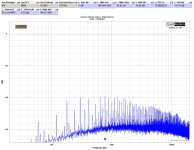
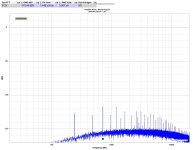
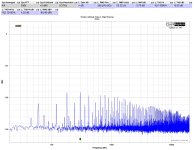
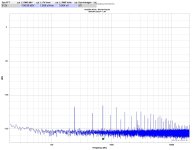
I've never tried shorting the inputs for the noise measurements. Wonderful suggestion!
Here's a before and after... That's now part of my process. Very interesting. Also, for full transparency, the amplifier was measured sitting in the rack with all sorts of other nonsense spewing nasty EMI toward it, so no doubt I'm also measuring things not associated directly with the amplifier, but it's measured in it's "natural environment.
Also, a totally irrelevant side note, but the amp does have a slight turn-on thump. Nothing concerning, but it's there.






Shorting inputs is a standard procedure for noise measurements. Otherwise, high input impedance allows for EMI incursion. While measuring single uV levels and below, there is always something “in the air” around.I've never tried shorting the inputs for the noise measurements.
Your noise measurement is now close to mine(post #4) with noise peaks at 1.6 uV. It is nice to observe nothing at 120 Hz. Confirms PSRR performance of both amplifier and voltage regulators. 🙂
Distortion measurements for high power are spot on, but at 1W, measured distortion is actually from QuantAsylum. In example, measured distortion for 1W and 15W into 8Ω are almost the same: 0.00068% and 0.00076%. Result for 1W is not right.
I’ve used measurement equipment with own total distortion at 0.000001% level.
https://www.diyaudio.com/community/...na-70-to-outperform-apx555b-for-30000.386001/
Binning lateral MOSFETs by Vgs is useful for paralleling them in a powerful output stage. With this amplifier, it can’t bring any benefits.Is there value in picking a specific "select color code" for the laterals from Profusion?
Hello Tombo
Thank you for your work it's a realy nice project.
On your Amp picture in the first post, what is the PCB you use between the two transformers ?
is it a speaker protection and what do think about SSR relay
Thank you for your work it's a realy nice project.
On your Amp picture in the first post, what is the PCB you use between the two transformers ?
is it a speaker protection and what do think about SSR relay
@By ZOLTAR
It’s a ground loop breaker pcb. Here is the info, gerber, etc…
My opinion: SSR Relays are completely fine as long as the intrinsic THD levels of the relay (hopefully mosfet based) is lower at ALL POWER levels that the amp can deliver. Most of the speaker relays I have seen cannot satisfy this requirement especially with super low distortion amplifiers like this one. I only use Neurochrome’s Guardian designs ($$).
Best,
Anand.
It’s a ground loop breaker pcb. Here is the info, gerber, etc…
My opinion: SSR Relays are completely fine as long as the intrinsic THD levels of the relay (hopefully mosfet based) is lower at ALL POWER levels that the amp can deliver. Most of the speaker relays I have seen cannot satisfy this requirement especially with super low distortion amplifiers like this one. I only use Neurochrome’s Guardian designs ($$).
Best,
Anand.
Hi By ZOLTAR.
It is a soft start circuit, my compact version similar to one available at the diyAudio store:
https://diyaudiostore.com/collectio...speaker-turn-on-delay-and-dc-protector-boards
Regarding SSR DC protection, it is way better solution than any electromechanical relay based one. Their distortion is very low but “no measurable effect” would be hard challenged with this amplifier. However, I believe their effect on sound wouldn’t be audible.
It is a soft start circuit, my compact version similar to one available at the diyAudio store:
https://diyaudiostore.com/collectio...speaker-turn-on-delay-and-dc-protector-boards
Regarding SSR DC protection, it is way better solution than any electromechanical relay based one. Their distortion is very low but “no measurable effect” would be hard challenged with this amplifier. However, I believe their effect on sound wouldn’t be audible.
Thanks Tombo for your reply.
The SSR mosfet relay is very well technically documented on diy sites but nobody talks about the music subjective perception
if the difference is audible or not
i am very attached to Wide and deep soundstage with natural vibratos that's why i still hesitate between those two technologies
and i know when you add a new component in amp it can be much better or alter the sound, like for example a Ccap miller compensation should be neither too low nor too high
The SSR mosfet relay is very well technically documented on diy sites but nobody talks about the music subjective perception
if the difference is audible or not
i am very attached to Wide and deep soundstage with natural vibratos that's why i still hesitate between those two technologies
and i know when you add a new component in amp it can be much better or alter the sound, like for example a Ccap miller compensation should be neither too low nor too high
@By ZOLTAR
And you will now become the FIRST who will describe before and after subjective perceptions in detail… yes? Then there will be no more ‘nobody’ and there will be ‘somebody’!
I have done before/after comparisons with the aforementioned Neurochrome Guardian units and don’t hear a difference but I haven’t written any detailed reviews.
Best,
Anand.
The SSR mosfet relay is very well technically documented on diy sites but nobody talks about the music subjective perception
if the difference is audible or not
And you will now become the FIRST who will describe before and after subjective perceptions in detail… yes? Then there will be no more ‘nobody’ and there will be ‘somebody’!
I have done before/after comparisons with the aforementioned Neurochrome Guardian units and don’t hear a difference but I haven’t written any detailed reviews.
Best,
Anand.
When I started to use SSR DC speaker protection boards I was skeptical also, I listened with and without in the first couple of amplifiers I used them in. I couldn’t tell any difference. Since then, the SSR protection boards are installed in every amp I build, besides single power rail cap coupled amps.
Attachments
Soundstage is very important to me as well.i am very attached to Wide and deep soundstage with natural vibratos that's why i still hesitate between those two technologies
and i know when you add a new component in amp it can be much better or alter the sound
I didn’t use any DC protection solution so far, so can’t say if it could affect any soundstage nuance, but as Vunce and poseidonsvoice share their considerable experience, it is expected that it would not.
I'm getting close to a Profusion order for the Exicon laterals. Is anyone who is in the USA interested in going in on an order of 25qty each lateral to get the price break? I'd be willing to order them if I know at least a few folks are willing to split the total cost. The total for 25 pairs of the "select grade" is around $540, so $21.60/pair, plus the shipping cost from my place to yours. Just curious if other builders want to combine our efforts to save. PM me if you're interested. If I get enough interest I'm willing to place the order and work on logistics after that to distribute. The laterals are the only components I still need to acquire and have been holding off on due to price after shipping from UK for small quantity (~$46/pair!!). Just a floater balloon to see if there's interest.
Thanks to @tombo56 for a great "ultimate low power class A" project!
Thanks to @tombo56 for a great "ultimate low power class A" project!
- Home
- Amplifiers
- Solid State
- Building an ultimate low power class A amplifier – my way
